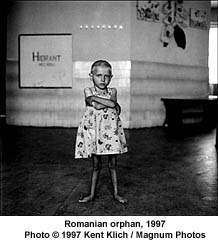|
NAN RICHARDSON,
publisher of Umbrage Editions, is producing a project that includes
a book, exhibition, and educational project on global AIDS, including
a two-hour film by Rory Kennedy. The project addresses, among other
topics, the history of AIDS in photography:
The visual arts have been permeated by AIDS. The growth of the epidemic
has torn deeply into the personal, the social, the moral and the political
fabric of our society. In photography, that most permeable of mediums,
you have a mirror of what the rest of society has experienced, heightened
by the fact that so many photographers and artists have experienced
AIDS in a very direct way: it has touched their own lives or those of
acquaintances and colleagues dealing with the disease; many photographers
have spent time documenting it. So AIDS is a huge and dominant subject
in photography of the past two decades, as it is, in fact, in any other
artistic medium.
 That
said, the range of photographic depiction of AIDS is wide and diverse,
as is the medium itself. You have powerful coverage from countries around
the world by photojournalists. Among those I would name are Kent Klich,
Gideon Mendel, and Alon Reininger. There is a long list of people who
have done remarkable work on AIDS as part of their greater body of work,
ranging from Steve Hart and Eugene Richards to Paulo Pellegrin and Paul
Fusco. That
said, the range of photographic depiction of AIDS is wide and diverse,
as is the medium itself. You have powerful coverage from countries around
the world by photojournalists. Among those I would name are Kent Klich,
Gideon Mendel, and Alon Reininger. There is a long list of people who
have done remarkable work on AIDS as part of their greater body of work,
ranging from Steve Hart and Eugene Richards to Paulo Pellegrin and Paul
Fusco.
You have artists who’ve visualized AIDS in scientific-artistic
ways. I think of Nancy Burson’s first imaging of the T-cell as
an early and significant photograph that is still an important part
of the history of the depiction of AIDS. You have people who’ve
dealt with AIDS through portraiture and personal documentation: Nan
Goldin and David Armstrong, and in a different vein, Nick Nixon and
Rosalind Solomon (whose portraits were shown a very long time ago and
are a significant part of that history); Scott Thode, who did a whole
series of portraits of people living with AIDS and had a long-term involvement
with those individuals; as did Merry Berridge and Thomas McGovern, among
others. Then you have people whose resonance is felt in the art world,
who chose more metaphoric responses to depicting the disease: Robert
Mapplethorpe, John Dugdale, Gilbert & George, Felix Gonzalez-Torres.
Photography was also key to the efforts of groups like Gran Fury and
Act Up who used it in graphic ways to agitate for awareness and action.
So you have a disease that has been singularly well-documented because
it is such an inextricable part of the history of our time.
The perception of AIDS initially entered our culture in a way that was
extremely narrow. The attention that photography paid to it, the artistically
and journalistically diverse responses to it, expanded our understanding
of AIDS in a way that was parallel to the path of the disease’s
devastating spread into every corner of our world.
|
 That
said, the range of photographic depiction of AIDS is wide and diverse,
as is the medium itself. You have powerful coverage from countries around
the world by photojournalists. Among those I would name are Kent Klich,
Gideon Mendel, and Alon Reininger. There is a long list of people who
have done remarkable work on AIDS as part of their greater body of work,
ranging from Steve Hart and Eugene Richards to Paulo Pellegrin and Paul
Fusco.
That
said, the range of photographic depiction of AIDS is wide and diverse,
as is the medium itself. You have powerful coverage from countries around
the world by photojournalists. Among those I would name are Kent Klich,
Gideon Mendel, and Alon Reininger. There is a long list of people who
have done remarkable work on AIDS as part of their greater body of work,
ranging from Steve Hart and Eugene Richards to Paulo Pellegrin and Paul
Fusco.